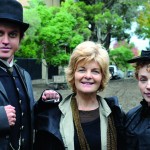My Place: history for families
 Capturing the essence of and recreating 220+ years of modern and indigenous history is no easy task, but Penny Chapman has turned a storybook My Place into a very special place for all Australians.
Capturing the essence of and recreating 220+ years of modern and indigenous history is no easy task, but Penny Chapman has turned a storybook My Place into a very special place for all Australians.
Trees are the oldest living creatures on earth and, in My Place, one of them bears witness to the stories of a community and, particularly, its children. Going back in time 10 years every week starting in 2008, the series presents a moment in the life of a local child and, most importantly, captures the issues and changes that have shaped our nation.
Based on Nadia Wheatley and Donna Rawlins’ 1988 book, the first series spans 130 years and covers moments such as the apology to the stolen generations, the arrival of different migrant communities, and Vietnam and the two World Wars.

